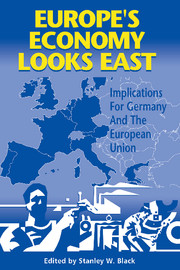Book contents
- Frontmatter
- Contents
- List of figures and tables
- Preface
- List of conference participants
- List of acronyms
- 1 Introduction
- I Trade relations
- 2 An economic assessment of the integration of Czechoslovakia, Hungary, and Poland into the European Union
- Comments
- 3 Potential trade with core and periphery: industry differences in trade patterns
- Comments
- 4 Impact on German trade of increased division of labor with Eastern Europe
- Comments
- II Investment patterns
- III Labor market issues
- IV The process of integration
- Index
4 - Impact on German trade of increased division of labor with Eastern Europe
Published online by Cambridge University Press: 03 February 2010
- Frontmatter
- Contents
- List of figures and tables
- Preface
- List of conference participants
- List of acronyms
- 1 Introduction
- I Trade relations
- 2 An economic assessment of the integration of Czechoslovakia, Hungary, and Poland into the European Union
- Comments
- 3 Potential trade with core and periphery: industry differences in trade patterns
- Comments
- 4 Impact on German trade of increased division of labor with Eastern Europe
- Comments
- II Investment patterns
- III Labor market issues
- IV The process of integration
- Index
Summary
Introduction
Following the recent political developments in Central and Eastern Europe, a transformation of the former centrally planned economic system into a marketbased economic order with decentralized decision making is underway. This implies radical social and economic changes in these countries affecting the economic interdependence between Central and Eastern European countries (CEECs) themselves, as well as their economic relations with Western industrial countries and developing countries.
After the collapse of the Council for Mutual Economic Assistance (CMEA), trade relations between the former centrally planned economies declined dramatically, whereas their trade with Western industrial countries quickly expanded. One can assume that economic relations between Eastern and Western Europe will intensify further in the medium and long term. Regional proximity and the positive effects of an international division of labor on productivity, but also the political urge to decrease the economic and social gap between Eastern and Western Europe, point to this trend. Furthermore, for political reasons trade relations between East and West until the collapse of the old system remained considerably low in comparison to a “natural” level of economic interaction. The changes in CEECs will have substantial effects on other countries in general and, in particular, on Western Europe. Within Western Europe this is especially true for Germany and Austria. The pace at which these processes will occur, however, depends to a considerable extent upon how fast the transformation in the various Eastern European countries will result in economic growth.
- Type
- Chapter
- Information
- Europe's Economy Looks EastImplications for Germany and the European Union, pp. 100 - 156Publisher: Cambridge University PressPrint publication year: 1997
- 2
- Cited by



